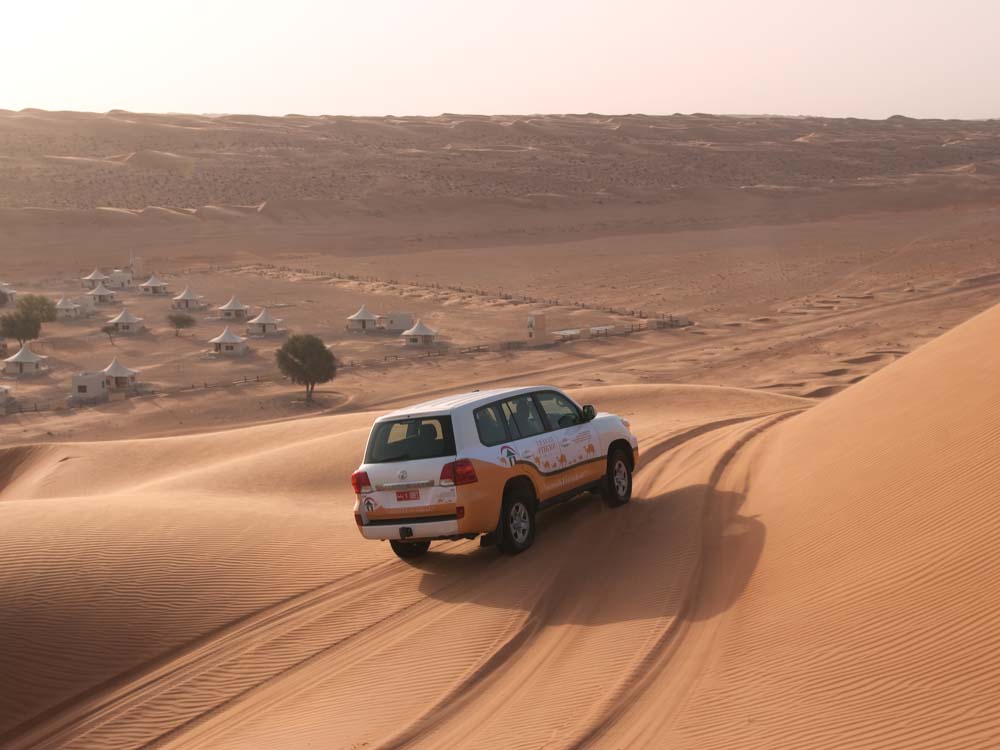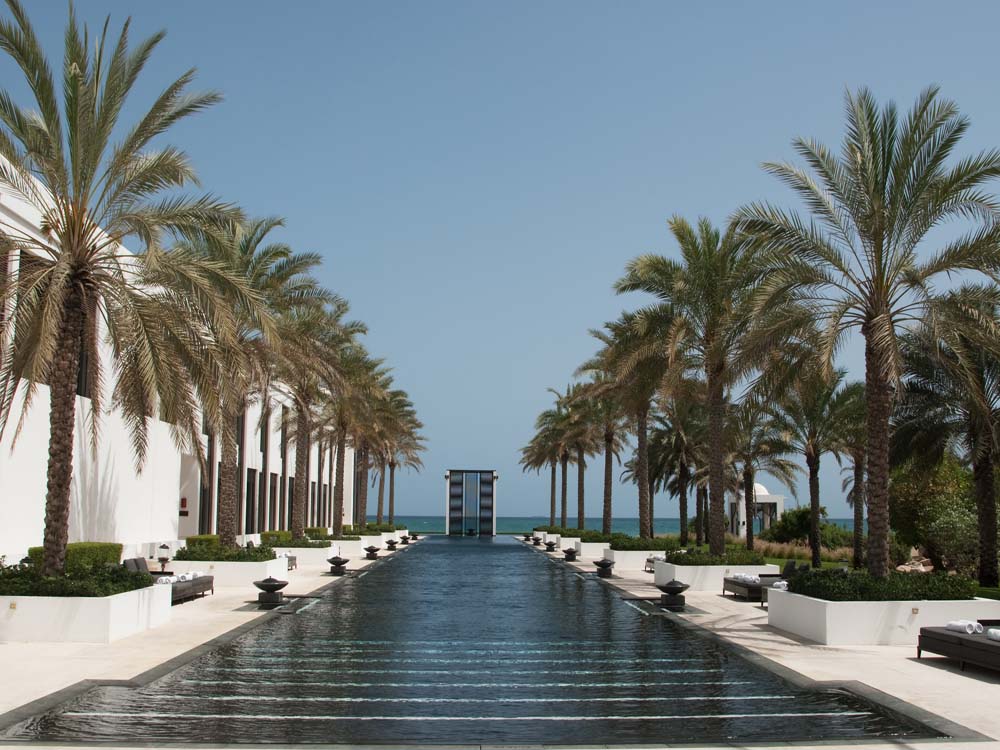The Big Trip: Oman
Wondering where to go for some winter sun? With its classic deserts, rose-speckled mountains and gorgeous blue seas, Oman could well be the answer

Wondering where to go for some winter sun? With its classic deserts, rose-speckled mountains and gorgeous blue seas, Oman could well be the answer
Wondering where to go for some winter sun? With its classic deserts, rose-speckled mountains and gorgeous blue seas, Oman could well be the answer
Oh, the wonders of modern travel! Yesterday evening I was shivering in grey and gloomy Britain, now I'm enveloped in a heavenly 30°C heat and surveying the smooth, soothing sands of the Arabian desert. It takes just over seven hours to fly south from London to the Sultanate of Oman, a magic carpet ride that delivers a lot more than instant winter sunshine. Touching down in this dry and crusty world of story-book forts, sugar-cube white houses and camels decoratively set beside palm-filled oases, there's a clear sense of tuning into a hot, harsh landscape where man has been cutting a wary deal with nature for centuries.
With so much of the Middle East and North Africa in turmoil, it's a blessing that this long, mountainous country bordering the Arabian Sea has remained safe and stable, thanks to the benign dictatorship of its 75-year old ruler, Sultan Qaboos bin Said al-Said. It's a special day for His Majesty when we arrive in the capital, Muscat, so my wife is given a celebratory welcoming rose as we pass through Immigration – and you don't get that at Heathrow.

Dune roaming: a sunset drive at Desert Nights Camp © imagepalace.co.uk
A recent report by the World Economic Forum declared Oman the ninth safest country in the world (we're 63rd), and the abiding mood is one of civility. Omani men sport a smart national costume of long white dishdasha and kuma (an embroidered cap that originated in Zanzibar), and unlike in the neighbouring UAE where you are overwhelmed with glitz, show-off architecture and expats, here you get to meet the locals. Omani men and women work across all levels of society, with the young often speaking good English.
While it's feasible to tour Oman as a self-drive holiday, we're grabbing a sneaky week away in winter so have opted for pre-arranged transfers. Just two hours after leaving Muscat, our affable driver Ahmed is stopping at Al Wasil to deflate the tyres of our 4x4 before we disappear into the apricot dunes of the Sharqiya Sands. Formerly known as the Wahiba Sands, this vast wilderness was famously crossed by the explorer Wilfred Thesiger in 1949. Today it is a choice spot for glamping, and our home for the next two nights is the enchanting Desert Nights Camp where your bedroom comes with a graceful tented roof and solid walls. Interiors reference Omani traditions with big wooden doors, chunky brass fittings and striped rugs, while an outside terrace offers the chance to sit on giant bean-bags contemplating the bewitching light of dawn and dusk.
Celebrity news, beauty, fashion advice, and fascinating features, delivered straight to your inbox!
The sense of getting back to fundamentals without sacrificing comforts is blissful. There's no TV or wifi, and thankfully no belly-dancers or boozed-up incentive groups. Dinner is a generous buffet under the stars that includes Arabic mezze, salads, barbecued meats and fish, with musicians softly playing the drums and oud (lute). The staff will drive you into the corduroy-like dunes to watch the sunset, or you can go for a 90-minute camel ride into the wilds and hairdryer-hot winds. We do this with a local Omani, Rashid, who turns out to be an IT graduate. While we stand on a dune top, dutifully contemplating the mysteries of life as another day comes to a flaming end, he squats in the sand with his smartphone. Our two camels, meanwhile, chew the cud with a wearied expression that clearly says 'come on, get on with it!'

Room with a mountain view: the Alila Jabal Akhdar sits 2000m up in the Al Hajar mountains
After the cloak-like heat of the desert, it's time to hit the cooler climes of the Al Hajar mountains which run the length of Oman like the spine of some prehistoric monster. Along the way we stop at Nizwa, a key city on the inland trading routes and a major Islamic cultural centre. Every Friday morning its souk overflows with goats, sheep, cattle and cars for sale. Picking our way through the piles of watermelons, carpets, camel accessories and earthenware pots, we reach a glittering emporium filled with dates, honey and halwa (similar to Turkish Delight) – if you've got a sweet tooth, Oman is your kind of heaven. Another star attraction is the restored 17th century Nizwa fort, which has panoramic views from the top and was built with ingenious dog-leg passages and 'murder holes' set in the roof that enabled defenders to pour hot date syrup onto attackers – the definitive example, surely, of coming to a sticky end.
Until 2005, much of the Jabal Akhdar mountains was reserved for military use. Now this is one of the most exciting areas in Oman to visit with new hotels opening up so both locals and travellers can appreciate its beauty. You still have to stop at a checkpoint before making the climb up to 2000 metres, and the warning sign 'Danger Steep Ascent' seems an understatement once we start winding our way up. The reward is a lofty Shangri-La with invigorating air and orchards of apricot, peaches, apples and walnuts that have a Mediterranean lushness.
Our destination is the end of the road, literally, where a new designer hotel, Alila Jabal Akhdar, has been spectacularly positioned on the edge of a 600 metre deep ravine. There's much to admire here, from the clouds of frankincense wafting through the lobby to the outdoor infinity pool with twin jacuzzis and a serene spa offering Asian-style therapies. All 86 rooms have balconies to drink in the mountain views and the restaurant serves yummy dishes like shorbat (Arabic lentil soup), grilled Omani lobster and date ice cream.

After the heat of the desert, it's time to go sailing: an Ocean Blue catamaran cruises the Omani coast
It's only when we get up at 5.30am to take a sunrise walk with Majed, one the hotel's Omani 'leisure concierges', that we truly appreciate the Alila's stunning location as he leads us through the ancient juniper trees to contemplate the vertiginous drops below. On another day we take a 35-minute drive to Al Ayn, a village famous for its pomegranates and production of rosewater – a skill brought from Iran in the 17th century. You'll need to visit in April or May to catch the damask roses in bloom, when you can take a dreamy walk along the irrigation rills then see the back-room workshops where the petals are transformed into an essential ingredient used in perfumes, medicines and sweets.
From here the drive down to Muscat takes two-and-a-half hours, a jarring return to modern Oman with its majestic mosques, multi-lane highways and roundabouts decorated with enormous coffee pots and water jugs. The capital is spread along a dry, hilly coastline facing the Gulf of Oman and you can take in its key sights in a day. We find the Mutrah souk disappointing but don't miss the Royal Opera House with its Ferrero Rocher interiors, the magnificent Grand Mosque, and Bait Al Zubair, a switched-on heritage museum, arts space, cafe and gift shop in Old Muscat.

The long game: the 103m pool at The Chedi Muscat © imagepalace.co.uk
After all that worthy sightseeing, we feel entitled to some R&R – and the coolest place to do this is The Chedi Muscat. Only 15 minutes from the airport with huge palm-filled gardens, white Moorish-style buildings, a private beach and three swimming pools (including one 103m long), this tranquil resort is ideal from some classy fly-and-flop with a palatial spa and complimentary yoga and pilates at weekends. We could have easily spent our whole holiday here, but Oman deserves exploring. On our last day we take a three-hour cruise with Ocean Blue on a 22m catamaran, sailing south to snorkel amid the clear waters and coral reefs of Bandar Khayran. Along the way our host, Clara, points out all the coastal sites where new luxury hotels are now arising. This is a desert getaway we're all going to hear a lot more of, and after a week discovering Oman's charms it's not hard to see why.
Book now
Oman Air (0844 482 2309; omanair.com) flies direct from London Heathrow to Muscat, from £479 return in February. Visas cost 5 Omani rials on arrival, take cash.
Stay at Desert Nights Camp (desertnightscamp.com), Alila Jabal Akhdar (alilahotels.com) and The Chedi Muscat (ghmhotels.com). Ocean Blue (oceanblueoman.com) offers sailing trips.
UK tour operators offering packages to Oman include Corinthian Travel (corinthiantravel.co.uk), Oman Holiday Architects (omanholidayarchitects.net) and Scott Dunn (scottdunn.com).
October to April are the best months to visit but January/February can be cool and rainy with temperatures much lower in the mountains.
Oman, UAE and the Arabian Peninsula (£19.99, Lonely Planet) covers the region, and see omantourism.gov.om.
Thumbnail and lead image © imagepalace.co.uk